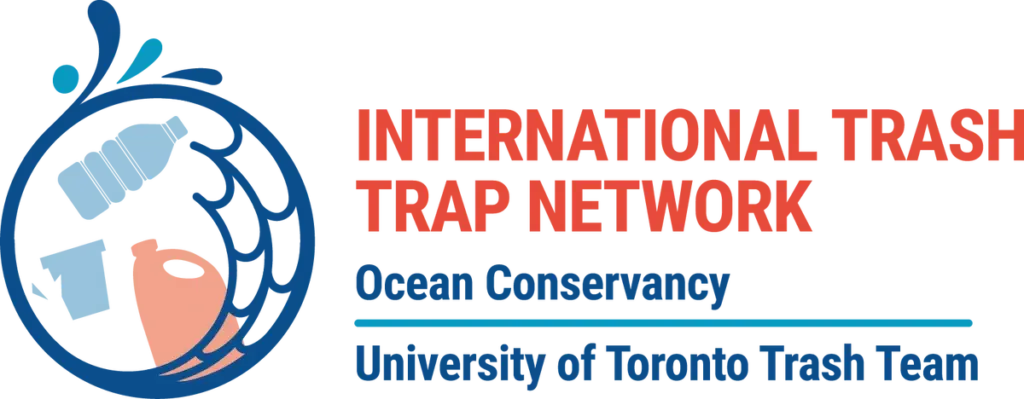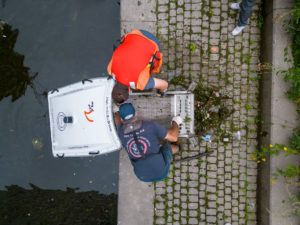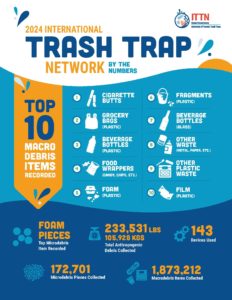
Globally, plastic pollution in marine, freshwater and coastal ecosystems is increasing. It is estimated that roughly 30 million tonnes of plastic waste entered aquatic ecosystems in 2020. If we continue business as usual, this number may increase as much as three-fold by 2030. Plastic pollution in the environment threatens wildlife, leaches toxic chemicals and fragments into micro- and nanoplastics. Reducing plastic production and improving waste management are vital to prevent global plastic pollution, but cleanup is also needed to mitigate the downstream impacts now and into the future.
Clean up using trash traps
Cleanups can have an important role in local strategies to tackle plastic pollution, and trash traps are technologies designed to clean up plastic waste from our aquatic ecosystems. By capturing and diverting plastic waste from the environment they supplement the work of community cleanups. Some even capture trash around the clock and target small plastic pieces, including microplastics that are often too challenging to collect by hand. By collecting data on what we collect, trash traps enable us to understand local pollution sources, support decision making for upstream solutions and monitor the efficacy of those solutions over time. They can also be a unique centerpiece for local education and outreach, raising awareness of plastic pollution, engaging community members and empowering positive change.
Connecting local solutions to tackle global plastic pollution
The International Trash Trap Network (ITTN), led by Ocean Conservancy and the University of Toronto (U of T) Trash Team, connects hundreds of local groups around the world through one global network, all using trash traps to increase cleanup efforts. The ITTN assists local trash trap programs to effectively clean up their local waterways and coastlines, collect harmonized data, engage communities, and inform upstream solutions.
Global cleanup database
Become a part of the network by contributing your trash trap data to our global cleanup database! The TIDES database includes trash trap cleanup data, manual cleanup data from the International Coastal Cleanup™ and data from other year-round cleanups led by groups and volunteers around the world. Data shared with us is summarized annually in ITTN reports and Ocean Conservancy’s International Coastal Cleanup™ reports. By combining our efforts as a network, we can amplify the impact of local programs and better measure our collective efforts to clean up plastic pollution globally. By sharing data we can support scientific research, educational initiatives and local and international policies to prevent plastic pollution.
When exploring this database, you can view data on a global scale or zoom into your local waterway, and easily download reports for any country, state, region or location to carry out your own analyses at any time.
Explore previous reports here:

Trash Trap Resources
The ITTN has developed a set of free resources for trash trap users that focus on three topics: project planning and implementation, data collection and education and outreach.
Project Planning and Implementation
Trash Trapping Project Checklist
The Trash Trapping Project Checklist is a step-by-step guide for new trash trapping programs, from identifying suitable locations for device installation, to considering local stakeholders to involve in the short and long term. We encourage groups to follow these steps for an impactful and sustainable trash trapping program.
Visual Audit
To get the most out of your trash trap it is best to target an area with the greatest plastic accumulation. We have developed a simple ‘Visual Audit’ method to assess your local waterway or coastline and use data from the field to inform a suitable location.
- Visual Audit Protocol
- Visual Audit Datasheet
- Visual Audit Data Template
Device Directory
To inform decision making on which trash trap is right for your scenario, the ITTN has compiled a device directory of trash traps used around the world in a variety of scales, technologies, and costs, including some low-cost and do-it-yourself examples. The directory is updated regularly, so please email us at [email protected] to receive the most up-to-date version.
Harmonized Data Collection
Data collection allows you to measure and expand your impact by measuring the efficacy of your trash trap and informing local upstream solutions to prevent plastic pollution. When you share data with the ITTN, you contribute to the global International Coastal Cleanup™ and its database. This public data can be used for scientific research, education and to inform policies and management actions from local to global. We have developed two harmonized data collection protocols (simple and detailed). Which protocol you use depends on time, people power and data collection goals. If you are using alternative methods for data collection but still record the weight and/or the count and categories of trash collected, you can still share your data and join the network.
- Simple Data Collection Protocol – Document the weight of trash (i.e., plastics and other anthropogenic litter) collected by your trash trap
- Detailed Data Collection Protocol – Document the weight, count and categories of trash (i.e., plastics and other anthropogenic debris) collected by your trash trap.
For groups trapping trash along coastlines, an adapted version of the protocol can be found below.
- Coastline Detailed Data Collection Protocol – Document the weight, count and categories of trash (i.e., plastics and other anthropogenic debris) collected by your trash trap when used to clean up coastlines.
Data Reporting
Clean Swell App: The quickest and easiest method for data reporting. This free app will automatically upload your trash trapping data to the TIDES database.
Datasheets: Email us your completed datasheets to share data with the network.
Simple Datasheet (PDF to print and use in the field)
Detailed Datasheet (PDF to print and use in the field)
Data Template (Excel file to download and fill in. For simple data reporting, only fill in relevant columns.)
Education and Outreach
These resources assist groups wanting to utilize their trash traps for local education and outreach and include an educator’s guide with instructions for carrying out several group activities, as well as a workbook for participants. The activities have been designed for participants aged between 8-12 but can be adapted for different age groups and audiences.
To inform the local community about your trash trap and its contribution to the ITTN, we have a flyer that can be printed and shared at local events. We also have a poster that can be positioned nearby your trash trapping site. To share about your work, these resources can be edited to add your organizational and collaborator logos.
Virtual Workshops
Our virtual workshops provide the tools necessary to inspire impactful and sustainable trash trapping programs. They connect local stakeholders and build capacity within specific regions for trapping trash as part of the solution to the global issue of plastic pollution. Within our workshops we share about trash trapping, the ITTN, and what makes a successful trash trapping project with speakers sharing their local experiences from different regions of the world.
Recordings from previous workshops can be found on the U of T Trash Team YouTube channel.
Get Involved
To get in touch with the ITTN, please fill in our contact form. You can also contact us via email at [email protected].
If you’re looking to connect with other groups in the network, join our ITTN Facebook Group. You can also follow us for updates on X and Instagram, and join our mailing list to be the first to hear about our latest resources, opportunities and other trash trap news.
